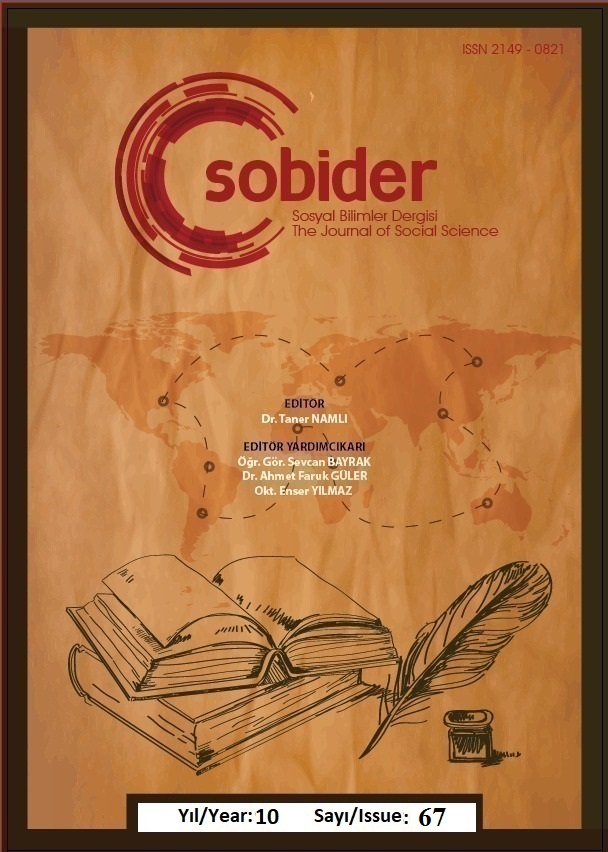Author :
Abstract
Doğa, ilk varoluştan bu yana insanların tuvali, kavramsal bir alanı haline gelmiştir. Yaşam kaynağı olan doğa, birçok sanatçının da ilham kaynağıdır. Önceleri atölyelerinde, sonraları ise doğaya çıkarak, izlenimcilerle birlikte onu resmetmeye başlamışlardır. Soyut sanatın da doğuşuna ortam hazırlayan doğa, gelişen teknolojik gelişme ve sanayi devrimi sonucu kentleşmenin de artmasıyla birlikte hoyratça kullanılmaya başlanmış, ondan faydalanma, zamanla yerini tahrip etme eğilimine bırakmıştır. Doğadan yararlanma güdüsü artık onu herhangi bir nesne gibi işlenip, satılabilen bir dönüşüme götürmüş, artan enerji ihtiyacı, yeraltında ve yer üstünde doğanın işlenmesine sebep olmuştur. Barınma ve birlikte yaşama ihtiyacı, kentleşmeyi meydana getirerek doğanın olumsuz etkilenmesine neden olunmuştur. Doğa ile denge içerisinde yaşama becerisini kaybetmeye başladığımız Sanayi Devrimi sonrasından 1960 yıllarına kadar olan süreçte toplumlarda meydana gelen sosyal değişimler karşında sanat alanı disiplinlerarası bir yaklaşım ile değişim ve dönüşüme uğramıştır. Değişim Avangard Dadacılarla birlikte içeri sanatına karşı alınan fikri tavırla, sergilenebilir nesneler üretmek yerine doğada yok olan, fotoğraflanabilir çalışmalar ile başlamıştır. Bu süreçte doğadaki bozulmaya karşı tavır geliştiren sanatçılar, sadece sergi ve galeri kısıtlamaları sebebi ile ortaya çıkmış olsa da çevre sanatlarını sanatın sembolik gücünü kullanarak doğanın döngüsünü, karşılaştığı problemleri, yine doğanın malzemelerini sanatlarında kullanarak kendilerini ifade etmeye çalışmışlardır. Beyaz küp dışında gerçekleşen bu çalışmalar faklı isimler adı altında tanımlanmaya başlamışlardır. ‘Arazi sanatı(Land Art)’ ‘Çevre Sanatı’ ‘Yeryüzü Sanatı’ ‘Ekolojik Sanat’ gibi tanımlamalar insanlardaki çevresel duyarlılığı ortaya çıkarmaya çalıştığı gibi bir kısım çalışmalar ise çevreye verdiği zararlar sebebi ile eleştirilerin odağı haline gelmiştir. Çalışmanın amacı, doğada oluşturulan bu sanatların örneklerle tanımlanması, doğaya etkilerinin ve etkileşimin ve doğa ile ne ölçüde uyumlu olduğunun incelenmesidir.
Keywords
Abstract
Nature has become a canvas, a conceptual space of humans since the first humans. Nature, which is a source of life, is also a source of inspiration for many artists. First in their workshops, then out into nature, they began to paint it together with the impressionists. Nature, which prepared the environment for the birth of abstract art, has been used rudely with the increase of urbanization as a result of the developing technological development and industrial revolution, and has left its place to the tendency to benefit from it and to destroy it over time. The instinct to benefit from nature has now taken it to a path that can be processed and sold like any other object, and the increasing need for energy has led to the processing of nature underground and above ground. The need for shelter and coexistence has led to the negative effects of nature by creating urbanization. In the process from the Industrial Revolution, when we started to lose the ability to live in balance with nature, until the 1960s, the field of art has undergone changes and transformations with an interdisciplinary approach, in the face of social changes in societies. The change started with the avant-garde Dadaists, with the intellectual attitude taken against the art of interior, with photographable works that disappear in nature instead of producing exhibitable objects. In this process, the artists who developed an attitude against the deterioration of nature tried to express themselves by using the environmental arts, the cycle of nature, the problems they encountered, and the materials of nature in their art by using the symbolic power of art, even though they emerged only due to exhibition and gallery restrictions. These works, which took place outside the white cube, started to be defined under different names. While definitions such as 'Land Art', 'Environmental Art', 'Earth Art', and 'Ecological Art' try to reveal environmental awareness in people, some studies have become the focus of criticism due to the damage they cause to the environment. The subject of the study is to describe these arts created in nature with examples, to examine their effects and interaction with nature and to what extent they are compatible with nature.





